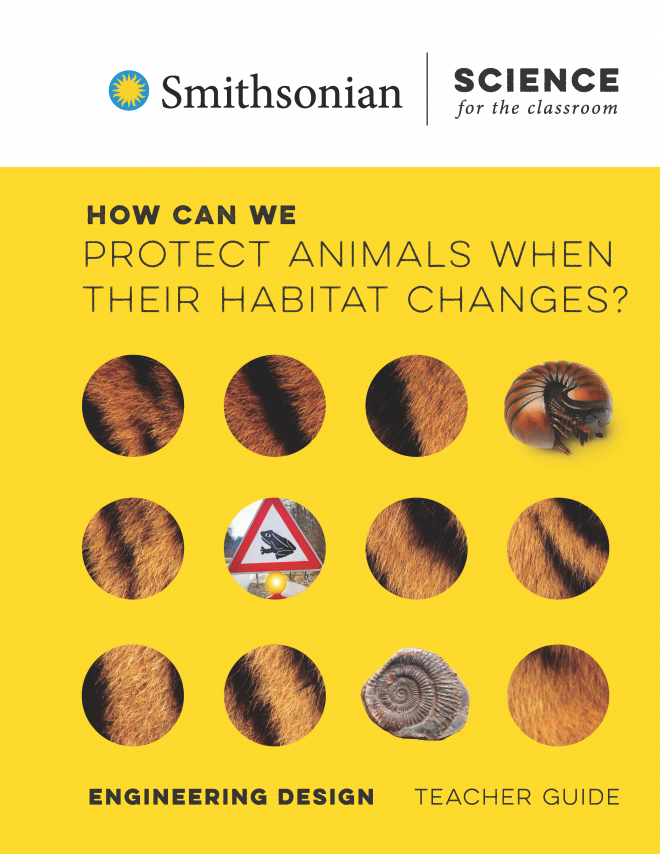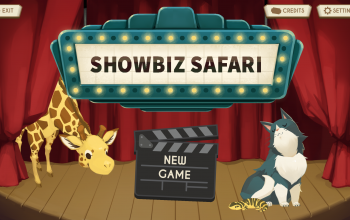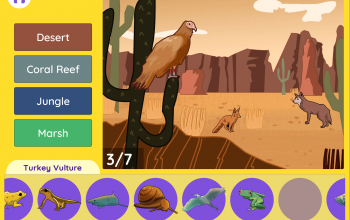How Can We Protect Animals When Their Habitat Changes?
How Can We Protect Animals When Their Habitat Changes?
How Can We Protect Animals When Their Habitat Changes? is part of Smithsonian Science for the Classroom, a brand new curriculum series by the Smithsonian Science Education Center. It is aligned to a group of grade 3 standards. It has a focus on engineering design, with a secondary focus on life science. In this module, students:
- Identify the problem of animal population decline caused by habitat change
- Design a classroom habitat where roly polys can survive
- Use camera trap data to explain why different animals live in different habitats
- Compare fossils to modern organisms to explain that habitats on Earth have changed
- Use a model of a tiger habitat to explain why tiger populations have declined
- Design a salamander tunnel that will reduce the deaths of salamanders on roads
Below are digital resources that support teaching of this module.
The Age of Humans: Evolutionary Perspectives on the Anthropocene
This website has more information on the Anthropocene epoch.
http://humanorigins.si.edu/research/age-humans-evolutionary-perspectives-anthropocene
Tiger Range
This file shows an illustration of the historic and present range of the tiger in Asia.
Download the Tiger Range PDF
Animal Needs
This video shows animals eating, drinking, keeping cool, keeping warm, hiding, nesting, and feeding young.
Download the Animal Needs Video
Download the Animal Needs Video Transcript
Panda Enclosure
This file shows an image of the panda enclosure at the Smithsonian National Zoological Park.
Download the Panda Enclosure PDF
Animal Needs
This video shows animals eating, drinking, keeping cool, keeping warm, hiding, nesting, and feeding young.
Download the Animal Needs Video
Download the Animal Needs Video Transcript
eMammal
eMammal is a Smithsonian-run website that allows groups to share and identify camera trap images.
https://emammal.si.edu/
The Science of Camera Traps
Alexandra Sanson, PhD, University of Oxford, and Roland Kays, PhD, North Carolina State University, discuss the use of camera traps in ecological research.
http://www.hhmi.org/biointeractive/science-camera-traps
Virgina Woodland
This file shows an image of a woodland habitat in Virginia.
Download the Virginia Woodland PDF
Woodland Animals
This file shows 30 images taken by camera traps in northern Virginia.
Download the Woodland Animals PowerPoint
Gorongosa National Park
This website is where citizen scientists can help scientists identify animals in Singita Grumeti Game Reserve, Tanzania.
https://www.zooniverse.org/projects/meredithspalmer/snapshot-grumeti/classify
Smithsonian’s Ocean Portal
The Smithsonian’s Ocean Portal has information on marine habitats and animals as well as resources for educators.
https://ocean.si.edu/
Open Ocean
This video shows a shark and a school of smaller fish swimming in the open ocean.
Download the Open Ocean Video
Download the Accessible Version of the Open Ocean Video
Download the Video Transcript
Coral Reef
This video shows a coral reef with many types of coral and small fish.
Download the Coral Reef Video
Download the Accessible Coral Reef Video
Download the Coral Reef Video Transcript
Sandy Beach
This video shows a crab moving forward and sideways on a sandy beach.
Download the Sandy Beach Video
Download the Accessible Version of the Sandy Beach Video
Download the Sandy Beach Video Transcript
Ocean Animals
This file shows images of each of the animals mentioned in the reading.
Download the Ocean Animals PowerPoint
Smithsonian Zoologist
This video is an interview with a Smithsonian zoologist who researches animals that live in the open ocean.
https://naturalhistory.si.edu/education/teaching-resources/life-science/ocean-biodiversity-discovering-marine-invertebrates
Conservation Comics
This website includes sample comics and a comic strip template developed by the Smithsonian.
https://earthoptimism.si.edu/resources/comic/
Paleozoic Ocean
This file contains a scene from the Smithsonian National Museum of Natural History showing what the ocean may have looked like in the Paleozoic era.
Download the Paleozoic Ocean PDF
Arthropods
This file contains an illustration of where the trilobite fits in the arthropods family tree.
Download the Arthropods PDF
Cassowary
This video shows a large cassowary walking around.
Download the Accessible Version of the Cassowary Video
Download the Cassowary Video Transcript
Rescuing Species
Elizabeth Hadly, PhD, Stanford University, discusses the effect of habitat loss on genetic diversity of tigers.
http://www.hhmi.org/biointeractive/rescuing-species
Tiger Background
This file contains images of the tiger range, a Bengal tiger, a village in India, and tiger food (sambar deer and cattle).
Download he Tiger Background PowerPoint
Animal Crossing
This video shows deer, moose, and a turtle crossing roads.
Download the Accessible Version of the Animal Crossing Video
Download the Animal Crossing Video Transcript
SPLAT Design Challenge
This file shows the models that students will use for the salamander and its pool as well as the criteria and constraints for the activity.
Download the SPLAT Design Challenge PowerPoint
SPLAT Design Challenge
This file shows the models that students will use for the salamander and its pool as well as the criteria and constraints for the activity.
Download the SPLAT Design Challenge PowerPoint




Kit Tips & Tricks